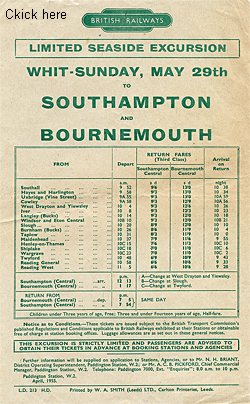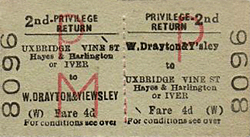|
 Notes: The branch from West Drayton to Uxbridge was authorised
in 1853. Work on the line which was just over two miles in length,
started in 1854 and following a Board of Trade inspection the
first passengers were carried on 8th September 1856. The terminus
at Uxbridge faced onto Vine Street and consisted of a single storey
'L' shaped building with a covered concourse leading to the central
island platform. This was flanked on either side by two shorter
narrow platforms. The station was also provided with an overall
roof (trainshed). The branch had one intermediate station at Cowley
which was added in 1904. Notes: The branch from West Drayton to Uxbridge was authorised
in 1853. Work on the line which was just over two miles in length,
started in 1854 and following a Board of Trade inspection the
first passengers were carried on 8th September 1856. The terminus
at Uxbridge faced onto Vine Street and consisted of a single storey
'L' shaped building with a covered concourse leading to the central
island platform. This was flanked on either side by two shorter
narrow platforms. The station was also provided with an overall
roof (trainshed). The branch had one intermediate station at Cowley
which was added in 1904.
A single road brick engine shed and turntable was sited on the
east side of the station while the goods yard with a brick built
goods shed was sited on the west side.
 The single track broad gauge line was an immediate success but
in 1871 the track was re-laid as standard gauge with the line
reopening on 9th October 1871 with some trains now running through
to and from Paddington. Both passenger and freight traffic continued
to increase and in 1881 it was necessary to double the line after
which a new service was introduced between Uxbridge and Aldgate
on the Metropolitan Line. The single track broad gauge line was an immediate success but
in 1871 the track was re-laid as standard gauge with the line
reopening on 9th October 1871 with some trains now running through
to and from Paddington. Both passenger and freight traffic continued
to increase and in 1881 it was necessary to double the line after
which a new service was introduced between Uxbridge and Aldgate
on the Metropolitan Line.
 The engine shed was closed in 1897 and in the early 20th Century
the station itself was threatened with closure to passengers following
a proposal to extend the line northwards to join the GWR at Denham.
This would have rendered 'Vine Street' redundant with a new station
being provided to the west of the town. At the same time the Metropolitan
Railway was also extending extending into Uxbridge with their station at Belmont Road opening in 1904. Although the line running south from Denham was
built and opened in 1907; it terminated at a new station called Uxbridge High Street and did not join up with the West Drayton line. Uxbridge now had
three stations so the terminus of the West Drayton line was renamed
Uxbridge Vine Street on 1.5.1907. The engine shed was closed in 1897 and in the early 20th Century
the station itself was threatened with closure to passengers following
a proposal to extend the line northwards to join the GWR at Denham.
This would have rendered 'Vine Street' redundant with a new station
being provided to the west of the town. At the same time the Metropolitan
Railway was also extending extending into Uxbridge with their station at Belmont Road opening in 1904. Although the line running south from Denham was
built and opened in 1907; it terminated at a new station called Uxbridge High Street and did not join up with the West Drayton line. Uxbridge now had
three stations so the terminus of the West Drayton line was renamed
Uxbridge Vine Street on 1.5.1907.
The first world war brought a reduction in passenger numbers
but these picked up again after the war. In 1923 the trainshed
roof was removed and replaced by a platform canopy and at the
same time the narrow platforms on either side of the central island
were cut back to a short stub. After the second world war passengers
were again in decline with commuters preferring the more convenient
and faster Metropolitan and Piccadilly line services into London
and once the line began running at a loss closure was inevitable.
Despite the usual public protests the station closed to passengers
on 10th September 1962. Although the freight service remained
profitable and the line was re-signalled, this only lasted until
24th February 1964 with final closure following on 13th July that
year when the parcels service was also withdrawn.
The track was lifted in March/April 1965 and the island platform was demolished shortly afterwards. The station building lingered a little
longer and for a short time was used for storage by a local retailer.
By early 1968 it was derelict and it was demolished the following
year. The stub of one of the side platforms remained at least
until the mid 1970's but the whole area was completely cleared
when the A4020 Hillingdon Road was realigned straight through
the station site part of which is also under an adjacent office
block.
 Today little remains of the Vine Street branch; Cowley Station
has also been demolished and all the bridges have been removed.
The cutting alongside Brunel University has been infilled but
a short length of track bed running parallel with Cleveland Road,
Cowley has been retained as a nature reserve and a short length
of broad gauge track has been laid along it. Today little remains of the Vine Street branch; Cowley Station
has also been demolished and all the bridges have been removed.
The cutting alongside Brunel University has been infilled but
a short length of track bed running parallel with Cleveland Road,
Cowley has been retained as a nature reserve and a short length
of broad gauge track has been laid along it.
Further reading: GWR Disused Stations in Greater London by J.E.
Connor - Connor & Butler 2000 ISBN 0 947699 31 7
Other web sites: Abandoned
Tube Stations - includes photographs of the branch in 2005. Tickets from Michael Stewart
See also Cowley |

 Home Page
Home Page 
 Home Page
Home Page